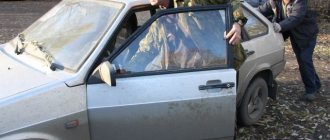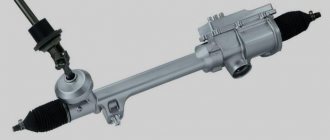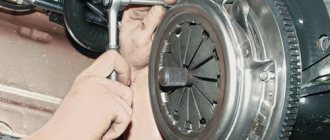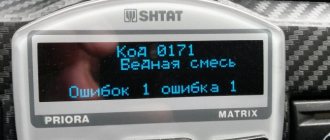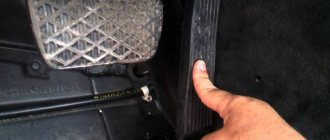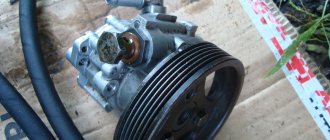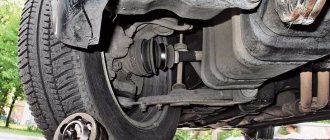Drivers often wonder why there is a hum in the car when driving. After all, the increased level of noise in the cabin causes unnecessary discomfort, making the trip quite unpleasant. It’s not for nothing that now, in addition to all other indicators, automakers indicate the level of noise insulation. Also, increased noise in the interior may indicate design flaws or malfunctions. Therefore, if you notice the appearance of a new noise while driving, most likely your car is signaling a breakdown.
In this regard, experts do not recommend making solid noise insulation; in this case, you simply will not be able to recognize the problem in a timely manner and fix it in a timely manner.
Natural noise
Why is there a hum in the car when driving? This question is often asked by frightened new car enthusiasts. After all, it seems to them that this is a harbinger of a serious breakdown. Yes, sometimes a car makes noise when it breaks down, but often the reason for this phenomenon is natural noise. They arise during the operation of certain mechanisms, and it is almost impossible to completely eliminate them.
Quite natural noise includes the operation of the engine and exhaust system, of course, if they do not exceed certain indicators. Also, you can often hear a hum in the cabin when driving on a not very good road. It occurs due to the tire tread catching on uneven roads. Tire manufacturers have been struggling with this problem for many years, but cannot solve it. The hum can also be caused by oncoming air resistance. This is especially evident in strong headwinds and high speeds. All of the noises listed are not dangerous and you should not be afraid of them.
Unnatural noises
Another category of hum includes signs of breakdowns. As a rule, the cause of the hum is faulty bearings. The breakdown of some of them is quite dangerous. Therefore, it is advisable to eliminate the source of noise as soon as possible. To do this, you need to know that different bearings hum differently. More precisely, their sound is approximately the same, but by the place where it comes from and how it reacts to your various actions, you can quite accurately determine the source of the unpleasant sound.
Most often, you can observe the howling from the front of the car. The hum is quite strong. It is often immediately noticeable that he is coming from a certain side of the car. If you notice exactly this phenomenon, then most likely the problem is in the wheel bearing. If you stop and touch the hub, it will probably be hot. With this problem, there is often an increase in noise when turning. This way you can determine which bearing is “sick”. An increased hum when turning right indicates problems with the right bearing. Accordingly, if all this happens when turning left, the problem is with the other hub.
It is approximately the same way to determine if the rear wheel bearings are faulty. All hub malfunctions must be repaired immediately after detection. A bearing that gets stuck while moving is guaranteed to lead to an accident.
A hum coming from the engine side may indicate a malfunction of a number of bearings. Therefore, here you need to pay attention to additional signs. An increased engine temperature indicates a pump malfunction. After all, a failed bearing prevents the device from performing its function normally. If you experience a hum while driving, and at the same time the motor begins to overheat, check the pump immediately. It is likely that the bearing will need to be replaced.
If you delay the replacement, then instead of a hum, a rather unpleasant knock will appear. Also, such a hum can be caused by the generator bearing. In this case, you can observe a decrease in the charging rate. True, this can only be assessed on cars equipped with a voltmeter.
By the way, if your car does not have soundproofing of the engine compartment on the engine side, then do not be surprised by this problem.
Sometimes the hum is not constant, but only when the clutch is pressed. The problem here is the release bearing. To eliminate the unpleasant factor, it is enough to replace the failed part.
Sometimes the driver is bothered by noise coming from below. There may be 2 reasons for this. Most often, such a hum occurs when the input shaft bearing on mechanical and robotic gearboxes is destroyed. To clarify the cause, you can perform a simple test. When driving, switch to neutral speed. If the hum is caused by a problem with the gearbox, it will disappear immediately. Please note that to replace the bearing, you will have to disassemble the box. This is a rather complex mechanism; if you are not confident in your abilities, it would be better to contact a car service. On rear-wheel drive vehicles, the hum may be caused by a worn universal joint. It is advisable to replace it.
Also, on some rear-wheel drive vehicles, the rear axle gearbox may howl. The sound is very characteristic, especially during acceleration. This problem is well known to owners of old Lada cars. The problem is solved by adding transmission oil to the gearbox. If this measure does not help, you will have to replace it.
Natural causes
Before you start figuring out what causes a hum in your car, you need to learn some basics. It should be understood that there will be noise in the car in any case and some sounds are considered normal. Thus, experts divide extraneous sounds in the car into several “types”: natural, unnatural and all others. If the driver hears strange noises that do not resemble natural ones, then he should carry out diagnostics and find out the reason for their occurrence.
Reasons for “normal” sounds:
During fast driving on the highway, a hum may be heard in the cabin due to the wind. This problem often occurs in cars with a small body. If you reduce the speed limit, the sound will disappear.
During operation, any internal combustion engine makes sounds and this is normal. However, sometimes the “engine” begins to make more and louder noise. This is a good reason to conduct a diagnosis.
Unpleasant sounds may occur while driving on a bad road. The coarse asphalt surface is to blame.
And the most obvious natural reason for the appearance of a hum is driving at high speed with the windows wide open.
The listed reasons are the “norm” and there is no need to look for faults in the car. There are a number of “noises” that can also be called safe. For example, the creaking of plastic parts in the interior is present in many car models. Using silicone lubricant will help solve the problem.
Some drivers attach a special additional rack to the roof. He is the one who can make loud sounds. This starts after the car accelerates to 60 km/h. Drivers note that only the iron lattice trunk makes noise, and not the streamlined plastic one.
And last but not least, it’s worth noting the accessories. Moldings on the hood and windshields on the doors - these elements, when poorly secured, make noise while the car is driving.
Other noises
In addition to the hum, you can hear other sounds in the cabin. The most disgusting phenomenon can be called vibration. Most often, it occurs when the engine mounting mounts have become loose. In this case, when the engine is idling, this phenomenon will only intensify. The problem is solved quite simply. You need to tighten the nuts securing the power unit, and the vibration will go away.
A sharp squealing sound coming from under the hood, which intensifies during acceleration, indicates the need to tighten or replace the alternator drive belt. First you need to assess its condition visually; if there is no damage on it, you should tighten it. Sometimes, this is enough. But, in the case when the squealing still does not stop, replace it with a new one. Experienced drivers always carry a spare alternator belt with them in case it breaks.
Causes of humming noise in the car when driving
If there is a hum , it may be a sign of a breakdown. A very common cause is faulty bearings. In some cases, their breakdown can be very dangerous. In this case, it is better to eliminate the source of noise immediately. Different types of bearings produce different noises. They have approximately the same sound, the source is determined by the point from which it comes. A hum when driving is often caused by the wheel bearing. As the steering angle of the wheels increases, it increases. If the movement occurs in a straight line, it disappears. When the car turns in different directions, the noise is not the same. At speeds above 60 km/h it becomes unbearable. In advanced cases, vibration of the car and steering wheel is added to the listed symptoms. Having heard a strong hum in the car , you need to find out its cause. You can diagnose a car with one drive yourself, alone, using a jack. For a four-wheel drive vehicle you will need a jack. Having found out the reason, the worn part is replaced with a new one. If there is a hum in the cabin, it may be the engine. The cause of increased noise and vibration is often the power unit. Other parts of the machine can also make unpleasant noises when they break down. Let's take a closer look at each of the possible reasons.
Wheel bearing failure
The bearing becomes a common cause of humming noise in the car. With this problem, the sound increases when turning. Stop and touch the hub: it will be hot immediately after driving. You can independently determine which wheel bearing has failed. If the noise increases when turning right, then the problem has arisen in the right bearing. When there is a hum when turning left, the left one is faulty.
Factors that indicate a bearing defect:
- Turning the steering wheel, the driver hears an increasing rumble. Increasing in one direction, it decreases when turning in the other.
- If the car picks up speed, the sound becomes louder.
- There is play in the steering wheel. Its vibration increases at speeds up to 100 km/h. This is clearly noticeable when driving on a flat road.
If the deficiency is not eliminated, the hum becomes increasingly stronger over time when the car is moving. Extraneous noise produced by a bearing is a good reason to eliminate the defect. Problems with the hub must be corrected as soon as they are identified. If a faulty bearing jams while the machine is moving, this will lead to an emergency. Bearing failure is detected even at low speed. This indicates his critical condition. It is unknown when exactly it will be completely destroyed. Therefore, it is important to identify the problem at an early stage and replace the part.
Operating a humming node has unpleasant consequences:
- Wheel runout can cause the brake pads to separate. This will result in the vehicle being unable to be stopped effectively.
- At speed, the assembly may completely overheat, the holder may collapse, and the wheels may become wedged.
- Possible loss of control of the machine.
How do you know when to repair the hub? The recommendation here is simple: at the first incomprehensible sounds, identify their cause. Do not use the hubs harshly. This will help prevent an accident.
Loose alternator or air conditioning compressor belt
If there is a hum in the car when driving, the cause may be the alternator belt. The car suddenly starts whistling. The driver does not immediately understand what exactly is going on. If the belt is not worn out or old, it can also make an extraneous sound . A working belt in a car is silent. It guarantees precise transmission of rotation, smoothes out jerks and shocks. If it is of high quality, it is designed for long-term loads. The alternator belt on modern models rotates not only the alternator, but also the air conditioning compressor and power steering pulleys.
If there is a malfunction, the belt emits a whistling sound, similar to a clang, which is clearly audible even at a distance. This unpleasant sound is due to the fact that it slips. It is not recommended to use the car with this malfunction. It happens that the car owner thinks that he got a low-quality belt. He makes a replacement, but soon everything happens again. Therefore, it is better to immediately do a full inspection of the belt drive.
Verification steps:
- determine the degree of integrity of the belt;
- check the tension;
- analyze the cleanliness of the shaft;
- check the pulleys for displacement.
A hum when driving , similar to a whistle, is a good reason to check the belt. In many cases it simply slips through. This effect may be caused by its weakening. Information about the optimal belt tension should be found in the vehicle manual.
Squeaking brake pads
Extraneous noise can be caused by brake pads. The sound in this case resembles a grinding and squeaking sound. This is considered a normal option, not a breakdown. This problem can be solved simply: by treating the pads with a special compound. Sometimes it is enough to roll them in for the jester to disappear. The braking system is a basic element of car safety. Its correct use is very important. In particular, the driver must use suitable and high-quality pads. In some cases, after replacing them, they make whistling and squeaking noises. Then you need to immediately inspect the details. Small pebbles caught between the pads can worsen the braking process. Then a characteristic squeak is heard. Using wire, stones can be easily removed. It happens that new pads squeak. They roll in after 200 km, the problem with extraneous noise solves itself. If the unpleasant sound remains, a good brake pad lubricant will help. It’s easy to apply it to parts with your own hands. To do this, you need to remove the wheel and lubricate the block with a thin layer. There are special compounds on sale that not only eliminate squeaking, but also partially restore parts, extending their service life.
Inner CV joint
If a hum when the car is moving appears after increasing speed and is accompanied by vibration, the cause may be the internal CV joint. During hard acceleration the sound is especially noticeable. When acceleration is completed, the vehicle stops vibrating. A malfunction of the internal CV joint - tripod - always causes the indicated effect. Usually the car vibrates a lot when accelerating. As soon as the driver takes his foot off the gas pedal, the car drives smoothly. A broken part may make a clicking noise that can be heard when it starts to move. Then they disappear and appear again the next time you move from a place. If you hear a crunching sound while the car is moving, you need to react immediately. This is a dangerous sign that a worn CV joint will jam in the near future. You cannot drive with this type of damage. You need to send the car on a tow truck to a workshop.
A severely worn part is completely replaced. If the CV joint is operational, it is returned to normal condition by changing the lubricant and boot.
Power steering pump
Noise in the car caused by the power steering indicates that it is faulty. The sooner it is eliminated, the better. A defect in the steering system creates the risk of an emergency. In this case, extraneous sound occurs in the space under the hood, during the rotation of the steering wheel.
A faulty pump is the most costly damage to your power steering. The main sign of a breakdown is an increase in the effort to turn the steering wheel. The reason for the hum produced by the power steering pump is broken parts: oil seal, impeller, bearings. The sound is similar to a squeal, whistle, grinding. The fact is that the working fluid is pumped by the pump. When turning the steering wheel, the load increases. If it is determined that the pump has a defect, it is replaced with a new one. Repairing such a part is possible, but there are no guarantees for this type of work.
Power steering hoses
After replacing the power steering hose, a hum may appear when driving the car. The reason here is the low quality of the part. There are service stations that install regular hydraulic hoses instead of special ones. The hum may be caused by air getting into the system. In some cases, this is accompanied by fluid leakage through the hoses. Removing air is quite simple: you need to open the power steering reservoir and turn the steering wheel several times until it stops. If there is no leak, the noise will disappear after the air is released. When a pipe leaks, it is important to find out the cause.
If there are malfunctions in the operation of the power steering: knocking, humming, the steering wheel turns with difficulty, there is no need to delay repairs. The condition of the steering system should be constantly monitored. This helps extend its service life.
Pump bearing
Extraneous noise is sometimes caused by a faulty cooling system water pump. A whining sound is considered a sign of a malfunction. It can occur due to the fact that the rotating impeller of the pump touches the bearing . If there is play in the pump pulley, it means the rotation bearing is worn out or damaged. Diagnostics is simple: just wiggle the shaft with your fingers. If there is play, it is felt immediately.
Generator bearing
If there is a hum when the car is moving and you suspect the alternator bearing, it needs to be checked. This is done simply and quickly. A slight humming noise may indicate serious problems with the generator. A car service center will determine how badly the bearing is worn. A sound resembling a grinding sound is considered especially dangerous. In this case, you need to urgently go for diagnostics. Most likely, the generator will need to be replaced. To check the generator, use a multimeter. You can do this yourself, but to fix the breakdown you need to contact a workshop.
Main shaft bearing
Partial failure of the input shaft bearing causes a hum in the car. The sound appears when the engine is running at first and second speeds, immediately after starting it. The destruction of such parts is considered a common problem. Bearings are constantly subject to heavy loads. Wear occurs earlier than other parts. The part is located on the input shaft, next to the oil seal. In some models it is combined with an oil seal. For a visual inspection, it is necessary to drain the oil and open the gearbox. If the bearing is intact, but there is no grease on it, a fresh layer of lubricant must be applied to it. A serious defect in the part causes a knocking noise when the engine is turned on. This may mean that the bearing is no longer suitable for further use and must be replaced.
Release bearing
If the car makes a loud noise , the cause may be a faulty release bearing. This occurs due to wear and tear or misuse.
The technical condition of a part is determined by characteristic features:
- If the assembly is destroyed, a crunching or loud grinding sound is heard when you press the pedal.
- Gear shift drive sticks
- The clutch pedal is too free.
- The clutch does not engage and disengage completely. This creates a burning smell.
The life of the release bearing is consumed faster due to dirt and dust getting into it. There is no need to delay eliminating the defect. Failure leads to transmission malfunctions.
Gearbox howls
The most common cause of abnormal noise in the front end of a vehicle is low oil level or poor transmission lube. The clanging sound intensifies as the car accelerates. Therefore, you should immediately check the oil level in the box. If it howls, it needs to be dismantled and diagnosed. If a defect is detected, carry out repairs. Another common cause of noise in the gearbox is partial failure of the bearings. In this case, the sound is similar to a hum. As you change gears the noise gets louder. Wear of synchronizers and gears also leads to howling. It gets stronger as the engine revs up. If the transmission is automatic, the torque converter may be causing the whine. It is not recommended to repair it yourself.
Low oil level in gearbox
Lack of oil in the box leads to difficult gear shifting and spontaneous gear shifting. Extraneous noise appears , oil leaks. The sounds appear at different moments: when the gearbox is turned on, in neutral, when the engine is running. Each noise option indicates a specific defect in the box. A specific breakdown can be determined by disassembling it. A low oil level in the gearbox causes rough gear clutches or poor idle shifting. Due to lack of oil, the box may freeze.
Rear axle gearbox
When the rear axle gearbox wears out, a noise appears in the rear of the car (for all-wheel drive and rear-wheel drive vehicles). As the speed increases, the noise increases. The reason may be poor lubricant or its evaporation from the gearbox. If the noise cannot be eliminated after changing the lubricant, the shank bearings are probably worn out.
Wear of the cardan shaft cross
The heart of the transmission is considered to be the driveshaft. If it vibrates, knocks or squeaks, its crosspiece needs to be repaired. The main malfunctions of the cardan are associated with it, as well as with wear of the wheel bearing . If a part is destroyed or jammed, play appears. The faulty driveshaft crosspiece must be replaced. Then you will be able to get rid of extraneous sound in the car while driving.
Unscrewed engine mounts
The purpose of the engine mount is to dampen the vibration that comes from the engine. In addition, it protects the power unit from impacts and jolts when driving. A knock in the engine indicates that the condition of the bearings needs to be checked. Unscrewed mounting pads can be identified by a rattling body, vibration of the steering rack and pedals.
Rubber on gearbox support
Transmission mounts are constantly subjected to high loads and vibration. The rubber on the supports wears out quickly. The supports should be replaced every 100 thousand km. If the rubber on the gearbox support is worn out, the car will start to make a noise when driving. The problem can be solved by replacing the tires.
Faulty hydropulsation dampers
In hydraulically driven systems, hydraulic pulsation dampers are installed. If they are faulty, vibration and hum will occur in the car. Dampeners are usually beyond repair. They are completely changed.
Using winter tires in summer
If the car hums , winter tires may be the cause. Extraneous sound is especially noticeable when used in the summer. Winter tires are made from a soft base, designed for low temperatures. When driving in warm weather, such tires sometimes make noise. By installing tires according to the season, the driver will get rid of it.
Improper wheel balancing
If there is a hum at speeds of 60 or more and vibration of the body, then maintenance must be performed. It may be due to improper wheel balancing. Clear signs of this are increased fuel consumption and loud noise. If an error was made during balancing, the wheel will move to the side and maneuverability will be impaired.
Incorrect tire installation
If simple tires can be installed almost without looking, then with complex tires there is more hassle. Tires that have a directional tread pattern are installed observing the direction of the pattern. Incorrect installation is detected by noise when driving.
FakeHeader
Comments 40
I have a Focus 2 2.0, I press the gas (especially during sharp acceleration) and I hear some kind of metallic ringing - what could it be? Several mechanics checked the motor, they all say it’s not the motor, but they can’t find the reason (((
I have a similar sound coming from under the hood (metal clanging). I traveled a lot for services, no one could determine where it came from. Eventually I discovered it. there is a metal protection on top above the catalyst, the fastenings broke and this sheet lay on the catalyst and rang
It seems like it has already been determined that the problem is in the PowerShift box, namely in the clutch. A common problem for the 3rd Focus with an automatic (robotic) transmission.
I accidentally read your noise, because... I also rummage through the forums. I have the same problem. I would like to know what was the matter? I interrupted all the forums and realized that the problem is in the clutch fork in A (for even gears) because... I get 3 and 5 without noise. It all started with a quiet noise during acceleration and braking, and ended with a grinding noise. In general, I'm afraid to remove the box from the OD, because... They’ll immediately put you in debt, everything is 2-3 times more expensive, I’ve had some trouble with the specialists, well, you can replace one fork, but it’s better to change the entire clutch assembly. because then problems will start with another fork with a release bearing, etc. If you sell, then you can replace the fork, and if for yourself, then buy the entire clutch for about 60 thousand.
I haven't done anything yet. At the next maintenance, the official updated my firmware. After this the car began to accelerate at higher speeds and the noise disappeared. But, be that as it may, this is a temporary measure, and therefore I am wary of the appearance of this noise again. Soon the heat will begin and we will see how the box behaves.
You described the symptoms of a dying internal CV joint.
Thanks for passing by

